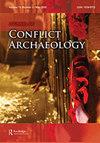全景观,松树和战俘:将冲突景观工具应用于拘留考古学
IF 0.6
0 ARCHAEOLOGY
引用次数: 2
摘要
军用地形分析系统KOCOA(关键地形、观测、掩护/隐蔽、障碍物和接近路径);也称为OAKOC或OCOKA)是在美国内战开始时作为军事科学新兴学科的一部分而发展起来的。它现在是国家公园管理局美国战场保护计划调查方法的一部分,由斯科特和麦克菲斯以及斯科特和布莱德引入冲突考古学,并被用作预测战场位置的工具。然而,它在战场之外还有潜在的应用。本文探讨了如何运用KOCOA阐明权力、支配和控制的冲突景观。通过对劳顿营(1864年的一个南方战俘营)的拘留景观的分析,以及对KOCOA的分析,将强调支配原则是如何应用的,以及隐藏和障碍是如何积极地破坏福柯的“不平等凝视”的。以及KOCOA如何在确定军事综合体构建环境要素的空间语法方面发挥作用;防御和观察与统治和控制同等重要。KOCOA在GIS环境中提供这些摘要的可视化,从而指导挖掘和解释。本文章由计算机程序翻译,如有差异,请以英文原文为准。
Panopticonism, Pines and POWs: Applying Conflict Landscape Tools to the Archaeology of Internment
ABSTRACT The military terrain analysis system KOCOA (Key Terrain, Observation, Cover/concealment, Obstacles, and Avenues of approach; also OAKOC or OCOKA) was developed as part of the burgeoning discipline of military science around the start of the American Civil War. It is now part of the National Park Service American Battlefield Protection Program’s survey methodology, was introduced to conflict archaeology by Scott and McFeaters and Scott and Bleed and has been used as a tool for predicting battlefield locations. However, it has potential applications beyond battlefields. This paper explores how applying KOCOA elucidates conflict landscapes of power, dominance, and control. An analysis of the internment landscape of Camp Lawton, an 1864 Confederate POW camp, with KOCOA, will highlight how principles of dominance were applied, and how concealment and obstacles actively disrupted the ‘unequal gaze’ of Foucault. But also how KOCOA functions in determining the grammar of space for elements of the constructed environment of a military complex; with aspects like defence and observation of equal weight with domination and control. KOCOA delivers the visualization of these abstracts within a GIS environment, and thus guides excavation and interpretation.
求助全文
通过发布文献求助,成功后即可免费获取论文全文。
去求助
来源期刊

Journal of Conflict Archaeology
ARCHAEOLOGY-
CiteScore
0.80
自引率
50.00%
发文量
8
期刊介绍:
The Journal of Conflict Archaeology is an English-language journal devoted to the battlefield and military archaeology and other spheres of conflict archaeology, covering all periods with a worldwide scope. Additional spheres of interest will include the archaeology of industrial and popular protest; contested landscapes and monuments; nationalism and colonialism; class conflict; the origins of conflict; forensic applications in war-zones; and human rights cases. Themed issues will carry papers on current research; subject and period overviews; fieldwork and excavation reports-interim and final reports; artifact studies; scientific applications; technique evaluations; conference summaries; and book reviews.
 求助内容:
求助内容: 应助结果提醒方式:
应助结果提醒方式:


